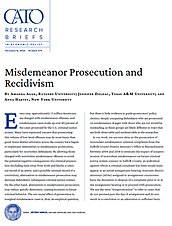In our work, we use new data on the prosecution of nonviolent misdemeanor criminal complaints from the Suffolk County District Attorney’s Office in Massachusetts between 2004 and 2018 to estimate the impact of nonprosecution of nonviolent misdemeanors on future criminal justice system contact. In Suffolk County, an individual against whom a criminal complaint has been issued must appear at an initial arraignment hearing. Assistant district attorneys (ADAs) assigned to arraignment courtrooms have the discretion to dispose of a complaint prior to or at the arraignment hearing or to proceed with prosecution. We use the term “nonprosecution” to refer to cases that do not proceed past the day of arraignment and do not result in a conviction or an admission to sufficient facts. “Prosecution” refers to all other cases. We use a model design that captures the effect of nonviolent misdemeanor nonprosecution on marginal defendants—that is, individuals for whom different arraigning ADAs might have made different prosecution decisions.
We find that going from the least lenient to the most lenient ADA increases a defendant’s probability of nonprosecution by about 10 percentage points (the mean rate of nonprosecution in our sample is 21 percent). Importantly, in Suffolk County, cases that move forward with prosecution after the arraignment are assigned to a different ADA, not the ADA at arraignment, allowing us to separately identify the effects of being assigned to a lenient arraigning ADA as opposed to a lenient ADA in other phases of the case.
We first estimate the impacts of misdemeanor nonprosecution on subsequent criminal complaints (arrests). We find that a nonprosecuted misdemeanor defendant is 33 percentage points less likely to be issued a new criminal complaint within two years post-arraignment (58 percent less than the average for defendants who are prosecuted). We also find that nonprosecution reduces the likelihood of a new misdemeanor complaint by 24 percentage points (60 percent less than the baseline average for prosecuted defendants) and reduces the likelihood of a new felony complaint by 8 percentage points (47 percent less than the baseline), though we did not find the latter to be statistically significant. Nonprosecution reduces the number of subsequent criminal complaints by 2.1 complaints (69 percent less than the baseline), the number of subsequent misdemeanor complaints by 1.2 complaints (67 percent less than the baseline), and the number of subsequent felony complaints by 0.7 complaints (75 percent less than the baseline). We see significant reductions in subsequent criminal complaints for violent, disorderly conduct, theft, and motor vehicle offenses. Our primary estimates follow defendants for two years post-arraignment, but we show that our results are robust to one-year and three-year post-arraignment windows (effects appear to grow over time). We also see similar declines in the probabilities of subsequent criminal prosecution and subsequent criminal record acquisition.
Misdemeanor prosecution may have negative effects for marginal nonviolent defendants because it may pull some defendants into the criminal justice system who otherwise would remain outside that system. If this is the case, then we would expect to see larger effects for first-time defendants relative to defendants who appear in our data at least once before. In line with this hypothesis, we find that our estimates are larger and more precise for first-time defendants.
We consider possible mechanisms that could be generating our findings. Cases that are not prosecuted by definition are closed on the day of arraignment. By contrast, the average time to disposition for prosecuted nonviolent misdemeanor cases in our sample is 185 days. This time spent in the criminal justice system may disrupt defendants’ work and family lives. Cases that are not prosecuted also by definition do not result in convictions, but 26 percent of prosecuted nonviolent misdemeanor cases in our sample result in a conviction. Criminal records of misdemeanor convictions may decrease defendants’ labor market prospects and increase their likelihood of future prosecution and criminal record acquisition, conditional on future arrest. Finally, cases that are not prosecuted are at much lower risk of resulting in a criminal record of the complaint in the statewide criminal records system. We find that nonprosecution reduces the probability that a defendant will receive a criminal record of that nonviolent misdemeanor complaint by 55 percentage points (over 50 percent of the baseline mean). Criminal records of misdemeanor arrests may also damage defendants’ labor market prospects and increase their likelihood of future prosecution and criminal record acquisition, conditional on future arrest. All three of these mechanisms may be contributing to the large reductions in subsequent criminal justice involvement following nonprosecution.
The results of our analysis imply that if all arraigning ADAs acted more like the most lenient ADAs in our sample when deciding which cases to prosecute, Suffolk County would likely see a reduction in future criminal justice involvement for these nonviolent misdemeanor defendants. Because nonviolent misdemeanor defendants in Suffolk County are disproportionately black, reducing the prosecution of nonviolent misdemeanor offenses would benefit black residents of the county.
We conclude by analyzing the effects of a policy change in Suffolk County establishing a presumption of nonprosecution for a list of nonviolent misdemeanor charges. We find outcomes that are consistent with our main results: increasing nonprosecution reduced the likelihood of subsequent criminal complaints within a one-year post-arraignment window. In addition, there does not appear to have been an increase in reported crime after the policy change.
Note
This research brief is based on Amanda Agan, Jennifer Doleac, and Anna Harvey, “Misdemeanor Prosecution,” NBER Working Paper no. 28600, March 2021, http://www.nber.org/papers/w28600.




